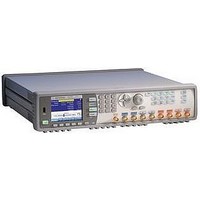81150A-002 AGILENT TECHNOLOGIES, 81150A-002 Datasheet - Page 23

81150A-002
Manufacturer Part Number
81150A-002
Description
NOISE GENERATOR, ARB/FREQ/PULSE, 120MHZ
Manufacturer
AGILENT TECHNOLOGIES
Datasheet
1.81150A-001.pdf
(34 pages)
Specifications of 81150A-002
Signal Generator Type
Pulse
Bandwidth
120MHz
Modulation Type
Amplitude/Frequency/Phase/Pulse
Supply Voltage Range
100V To 240V
External Height
108mm
External Width
439mm
Lead Free Status / RoHS Status
na
81150A Trigger Outputs
81150A Strobe Outputs
81150A Trigger Out1/Trigger Out2
1) For output frequencies > 120 MHz, the trigger rate is ¼ of the output frequency. If a frequency sweep or a FSK
A strobe output is provided for each channel on the front-panel of pulse generator 81150A.
The strobe output signal has a different function, depending on the mode of operation.
If no advanced mode is selected, the strobe output is a constant low.
In advanced mode internal/external triggered or gated burst, the strobe output provides
a signal indicating the duration of a burst. The rising edge of the strobe signal is synchro-
nized to the start of the fi rst waveform period in a burst. The falling edge is synchronized
to the start of the last waveform period in the burst.
In advanced mode sweep with the frequency marker off, the strobe output is a pulse with
half the duration of the sweep. The strobe signal goes high at the beginning of the sweep.
In advanced mode sweep with the frequency marker on, the strobe output goes high at
the beginning of the sweep and goes low at the marker frequency.
In pattern mode (block mode = On), the strobe output goes high at the beginning of the
pattern and goes low at the last bit of the pattern. Refer to the User Guide for more details.
In advanced mode internally / externally modulated (AM, FM, FSK, PM, PWM), the
strobe output is the analog modulation waveform.
81150A Strobe Out1/Strobe Out2
For 81150A, a separate trigger output is provided for each channel on the front-panel.
In advanced mode internally/externally modulated (AM, FM, PM, PWM), the trigger
output has the frequency of the unmodulated carrier waveform, with a 50% duty cycle.
For FSK modulation the trigger putput outputs the same frequency as the data output.
That is, it alternates between the two frequencies.
If noise is selected, a trigger signal is generated when noise is restarted
internally, externally or manually.
For all other modes of operation the trigger signal (TRIGGER OUT) marks the start of each
waveform period.
Output level
TTL
ECL
Pulse width
Internally triggered, continuous
Externally triggered
Transition time (20% to 80%)
Maximum rate
Impedance
Connector
Digital output level
TTL
ECL
Analog output level (modulator)
Impedance
Connector
Min pulse width
Transition time (20% to 80%)
frequency exceeds 120 MHz, the trigger rate is ¼ of the output frequency.
23
81150A
Selectable TTL/ECL
0 V / 2.5 V nom.
-0.85 V/-1.80 V nom.
50% duty cycle typ.
4 ns typ.
2.0 ns typ.
120 MHz
50 Ω nom.
BNC, front panel
81150A
Selectable TTL/ECL
0 V/2.5 V nom.
-0.85 V/-1.80 V nom.
-2.0 V to 2.0 V (full scale)
50 Ω nom.
BNC, front panel
4 ns typ.
2.0 ns typ.
(1)










